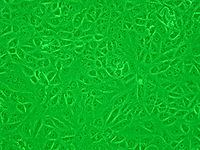
Back خلية فيرو Arabic Cèl·lula Vero Catalan Buněčná linie Vero Czech Vero-Zellen German Vero-ĉeloj Esperanto Célula vero Spanish Vero (cellule) French Células Vero Galician Sel Vero ID Cellula Vero Italian

Vero cells are a lineage of cells used in cell cultures.[1] The 'Vero' lineage was isolated from kidney epithelial cells extracted from an African green monkey (Chlorocebus sp.; formerly called Cercopithecus aethiops, this group of monkeys has been split into several different species). The lineage was developed on 27 March 1962 by Yasumura and Kawakita at the Chiba University in Chiba, Japan.[2] The original cell line was named Vero after an abbreviation of verda reno, which means 'green kidney' in Esperanto, while vero itself means 'truth' in Esperanto.[3]
- ^ History and Characterization of the Vero Cell Line -- A Report prepared by CDR Rebecca Sheets, Ph.D., USPHS CBER/OVRR/DVRPA/VVB for the Vaccines and Related Biological Products Advisory Committee Meeting to be held on May 12, 2000 OPEN SESSION www.fda.gov pdf
- ^ Yasumura Y, Kawakita M (1963). "The research for the SV40 by means of tissue culture technique". Nippon Rinsho. 21 (6): 1201–1219.
- ^ Shimizu B (1993). Seno K, Koyama H, Kuroki T (eds.). Manual of selected cultured cell lines for bioscience and biotechnology (in Japanese). Tokyo: Kyoritsu Shuppan. pp. 299–300. ISBN 978-4-320-05386-1.
© MMXXIII Rich X Search. We shall prevail. All rights reserved. Rich X Search